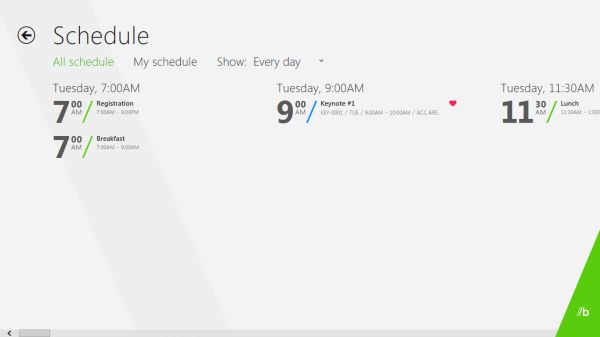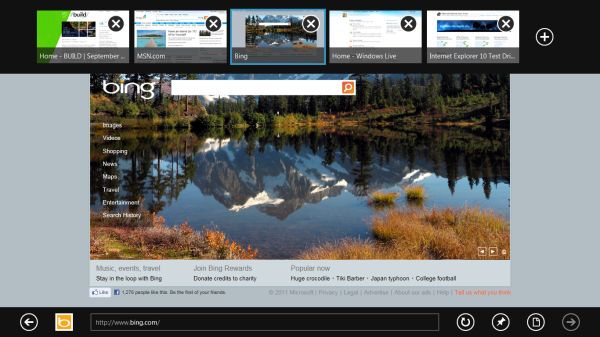Microsoft BUILD: Windows 8, A Pre-Beta Preview
by Brian Klug & Ryan Smith on September 13, 2011 12:05 PM EST- Posted in
- BUILD
- Windows
- Microsoft
- Windows 8
- Trade Shows
The Desktop User Experience & Business Use
While we’re primarily focusing on Windows 8 as a tablet OS since the hardware we used was a tablet, we also wanted to evaluate it some as a desktop OS. As the sample tablet was compatible with Bluetooth peripherals, we were able to pull out a BT keyboard and mouse and use it like a traditional laptop/desktop environment. With that said I’d like to preface our impressions with the following: as it stands Windows 8 is clearly focused on tablets first and Microsoft’s presentation was equally tablet focused, and it’s almost certain the experience will change before Windows 8 ships.
Overall Windows 8 is extremely jarring right now from a desktop user perspective. Metro is the Windows shell, no ifs ands or butts. Metro applications can only be accessed through the Metro shell (i.e. the Start Screen), and the Metro shell is always what the tablet will boot up into. Explorer as we know it is the Metro shell – if you kill it, you kill Metro shell with it – so at this time it’s not possible to boot up into the traditional Windows desktop. Even if you could, the Start Menu is gone, replaced with Metro charms.
So what we’re really evaluating is the ability to use the Metro shell and Metro applications with a mouse. For all the good Microsoft has done implementing multi-touch, the mouse has clearly suffered as it currently stands. Click & drag does not operate the same as tap & drag, which creates some oddities when you want to scroll around. In fact scrolling is probably the biggest oversight right now, as the Metro style dictates applications are laid out left-to-right rather than top-to-bottom. The mouse wheel will (slowly) scroll through tiles on the Start Screen, but in other places such as the Microsoft BUILD application the mouse wheel is useless. In its place you have to drag a scroll bar around, which is about as fun as it was prior to mice coming with a wheel.
Internet Explorer is particularly weird. Because it takes the full screen approach there isn’t a menu bar to speak of, and the tabs and URL bar are hidden. Invoking them requires right-clicking, with right-clicking pulling double duty as a way to open a link in a new tab and invoking the various bars. This also means that right-clicking for other purposes (e.g. View Source, etc) are unavailable.
The good news is that most of the traditional keyboard shortcuts still work, including Alt-Tab, WinKey + D, WinKey + E, and Ctrl-Alt-Esc. You can even Alt-Tab between launched Metro applications. The Start Menu search bar is also faithfully replicated on the Start Screen, so when you start typing Windows 8 will start narrowing down results of things to open. So overall keyboard users maintain much of their advantage in quickly executing applications. At the same time we’ve encountered fields that we can’t tab to, so not everything is working as it should.
While we’ve only had a short period of time work play with Windows 8 with a mouse and keyboard, at this point in time there’s not a lot to say that’s positive. Metro works well as a tablet interface, but with a mouse and keyboard it’s like using a tablet with a mouse and keyboard. Hopefully Microsoft will have a more suitable mouse & keyboard control scheme ready to go for Windows 8 farther down the line.
Windows 8 the Business OS
So far Microsoft has been focused on the consumer side of Windows 8, but business users won’t be left out in the cold. Windows 8 will also be the basis of a new version of Windows Server (also using Metro), and Windows 8 clients will have some new features.
The business additions announced so far for Windows 8 revolve around Remote Desktop and Hyper-V. Windows 8 Remote Desktop includes proper support for multi-touch controls, so tablets and other touch devices will be able to RDP into other machines and correctly interact with them. Meanwhile Windows 8 will add support for Hyper-V (previously it was Server-only), allowing Windows clients to spawn virtualized instances of Windows through the Hyper-V hypervisor.
Microsoft also used their discussion on the business side of Windows 8 to announce that Windows 8 will support installation onto and booting off of a USB drive, allowing business users to carry their copy of Windows with them. This has been a repeatedly requested feature for many years from more than just business users, so hopefully it will be everything everyone has always wanted.












235 Comments
View All Comments
UMADBRO - Tuesday, September 13, 2011 - link
Thankfully, I dont agree. Im actually going to give it a shot before I completely make up my mind about it. Maybe you should too.martin5000 - Wednesday, September 14, 2011 - link
I said I trying to like it, i.e. I haven't finished concluding my opinion of it. The problem is that every detail of metro I've seen so far is very disappointing.cfaalm - Wednesday, September 14, 2011 - link
I don't hate it. IIt just hasn't sunk into mee how this will be usefull for a deskttop, especially with professional applications that mostly require the whole screen, and want to run without much else going on. We need to know if we can tone it down and shut some of that stuff off.SteelCity1981 - Thursday, September 15, 2011 - link
This will be Vista 2.0. i'll be waiting for Windows 9.The ribbon menu is dumb if people didn't like it in office 2007 people aren't going to like it on their Windows!
The start menu is dumb. Why make the change to using a metro start menu when the regular one in Windows 7 worked perfectly fine.
Metro UI is really dumb. I want an actual desktop not something with a bunch of tiles all over the place as my main screen.
Ahmed0 - Thursday, September 15, 2011 - link
I actually got used to the ribbon in Office 2007. However, the problem lies in that the ribbon needs to be well executed for it to be useful. And to my frustration there are some programs that fail at it (like AutoCAD). After I install a program I shouldnt have to start customizing EVERYTHING just to be productive.Sadly, change doesnt necessarily mean progress. Its certainly not very wise to take one step forward in one area but two steps back in all the other areas.
With that said, Im not going to criticize W8 before I try it myself.
LoneWolf15 - Thursday, September 15, 2011 - link
I am trying it in a VM. And I'm hating it too.The thing that makes it perfect for smartphones and tablets (limited screen space, or lack of a keyboard) makes it crap on the desktop, at least so far.
I have a strong suspicion that MS will make it optional (turn on/off) in the final version. It's probably great for people who have a net-top with a touchscreen, but for a power-user, it just dumbs down the Windows interface to a point where it's inflexible, perhaps more difficult to use.
lurker22 - Tuesday, September 13, 2011 - link
Here's the deal. MS by changing the UI so dramatically in an attempt to keep the consumer market is going to now threaten its corporate customers. Fact is corporations use an OS to run applications, new UI means the corporation gets to re-train people. If you have to re-train people it's often not worth the expense, and it also opens the door to the question of "If we have to re-train everyone, do we really need to stay with Windows?"MS is damned either way I guess.
quiksilvr - Tuesday, September 13, 2011 - link
Who says this will EVER be in Windows Server? And you can disable Metro UI. You don't HAVE to use it.Ryan Smith - Tuesday, September 13, 2011 - link
From MS: "Metro is the Windows shell [...] from the smallest tablet to the server".quiksilvr - Tuesday, September 13, 2011 - link
Then their server team is just lazy. Why would you want this on your server? It makes no sense. The Windows 8 interface, yes, but that Metro UI skin? Hell to the no. It's like Themes and Desktop Backgrounds for Windows Server 2008, it makes no sense not to have it. Just a waste of space.